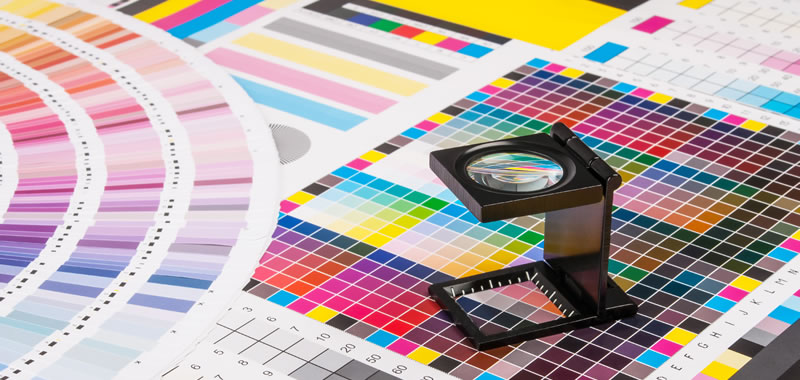
When you’re in the label printing business, you think a lot about color. To a layperson, a yellow is a yellow, a blue is a blue, and a purple is a purple. To a printing company, those simple descriptions of color are uncomfortably non-specific.
A color on a monitor screen can look very different when printed onto a label, which is why printing companies rely on color references instead. (Fun test: find the image of a red square further on in this blog, print it on a color printer and then compare it to what you see on your screen.)
In this article, we’ll delve into some of the science of color and explain the factors your label printer considers when you ask for a particular color. As you’ll learn, there’s more to color than meets the eye.
Identifying Color
When customers want color on their labels, they sometimes have a very specific set of colors in mind. Colors can be identified in many ways (like RGB or Hex) but typically, clients will communicate their color expectations in one of the following ways:
- They supply a PMS number. A PMS number refers to a color identified by the standardized Pantone Color Matching System.
- They provide a CMYK formula. The CMYK model refers to the colors used in four-color printing: cyan, magenta, yellow, and key (black).
- They give a physical sample and simply ask us to reproduce the color.
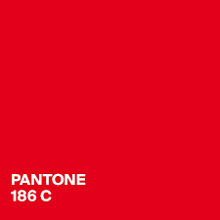 For example, a client could supply the PMS number 186 C for this cherry-red tone. Or, they could use the CMYK formula of 2, 100, 85, 6. Or, they could simply provide their red product and ask the label printer to reproduce the color.
For example, a client could supply the PMS number 186 C for this cherry-red tone. Or, they could use the CMYK formula of 2, 100, 85, 6. Or, they could simply provide their red product and ask the label printer to reproduce the color.
Any of those options will usually provide a color that accurately meets the client’s requirements. However, each of these ways of describing a color is subjective. They rely on standard systems of references, such as the Pantone colors.
If 100 percent objectivity is required, printing companies can use LAB values to identify colors. A LAB value represents a color using three factors: (L*) lightness, (A*) red-green, and (B*) yellow-blue. A LAB value is objective because it describes the light that is reflected off a colored surface, not the particular inks or screen values that went into making the color.
An expert printer can measure the LAB value of any given surface using a device called a spectrophotometer.
Printing Color Part 1: Running the Gamut
Identifying the color is one thing: printing it is quite another.
While the full spectrum of colors that exists in the universe contains infinite variations, printers are still constrained by the equipment and inks at their disposal. Every printer’s color system has its limits, which we call its gamut.
For example, here is a pictorial representation of the CMYK gamut (roughly 550,000 colors), showing all the different combinations of Cyan, Yellow, Magenta, and Black. These four colors are available on virtually all color printers, from professional press to at-home desktop printers.
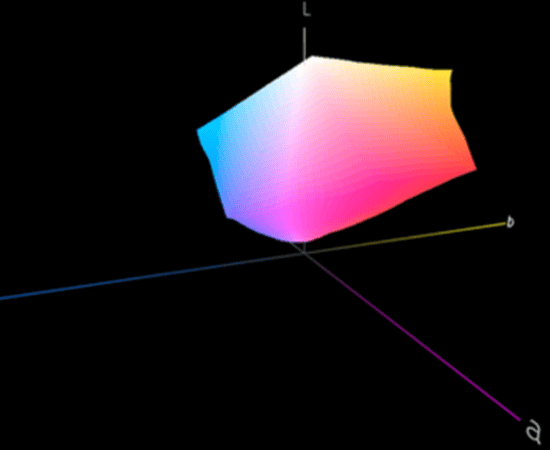
Now here is the same gamut overlaid with the RGB gamut. The RGB (red, blue, green) model is how your computer monitor defines colors.
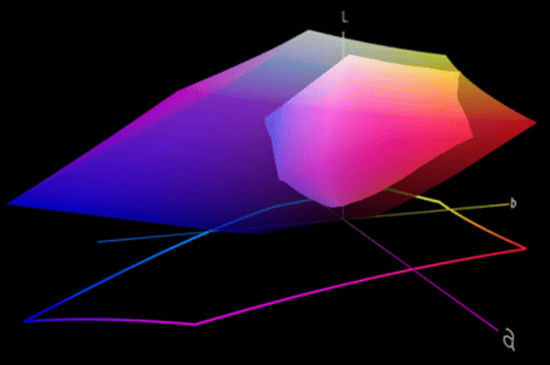
As you can see, there are quite a few colors in the RGB color space that are simply impossible to reproduce with the CMYK gamut available on most color printers. So, a color that looks perfect on your monitor may look completely off when converted to CMYK and printed.
This is why printing companies generally discourage clients from sending their artwork solely in PDF format: The color that appears on the screen will look very different when printed. And without reference numbers like CMYK or PMS, the printer has no way of knowing what the color is supposed to look like. (Read our recent Q&A for more tips on submitting your artwork to label printers.)
Here is one more color graph:
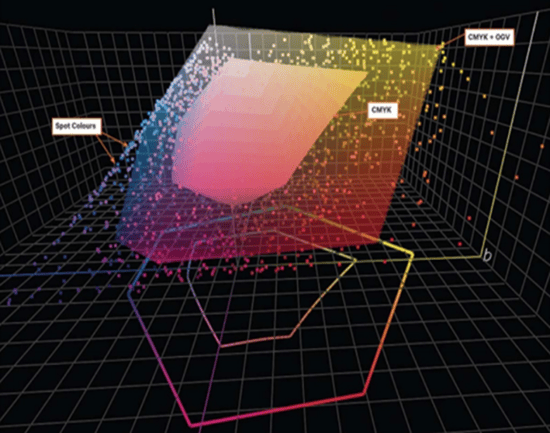
The solid shape in the middle is the CMYK gamut. The larger transparent shape is an extended CMYK gamut, with the addition of orange, violet, and green inks. Adding these three inks (note: several of the presses at The Label Printers have this capability) allows the printing of roughly 975,000 colors (versus 550,000 for CMYK alone).
So, what does this all mean? Well, the individual dots in the image are the Pantone colors. And as you can see, a large number of them fall outside of the standard CMYK ink range, and also outside of the CMYK + OVG range. Therefore, if the Pantone color you desire is outside of either of these gamuts, it’s time to start thinking about tolerance.
Printing Color Part 2: How Much Can You Tolerate?
The amount a printing company is allowed to stray from any color is called the tolerance. Clients may specify an acceptable tolerance in a spec sheet or a conversation. If the label is simply artwork and text, the customer might be okay with a certain level of tolerance. If it contains a logo, with a proprietary brand color (think of Coca-Cola red or Home Depot orange, for example), we might see the tolerance at very low levels.
To determine whether a color falls within acceptable tolerance, the printing company can measure each color’s LAB values and then calculate the “distance” between the printed color and the color originally requested. This distance is called delta e. Delta e values range from very large differences (about 100.00) to very small (about 0.01). Most humans can’t detect the difference between two colors with a delta e of 2.0 or less.
Sometimes, tolerance isn’t much of an issue. If the requested colors fall within the CMYK gamut, then the print job should be relatively quick and affordable.
If the difference between your desired color and the closest CMYK color is outside of your tolerance range— say, 3.0 or more — you and your printer will have some decisions to make, taking into account your budget and timeline.
Typically, the thinking process goes like this:
- How close can we get to the color using the CMYK gamut?
- Can we use the extended CMYK+OVG gamut?
- Should we purchase a spot color?
Any Questions?
At The Label Printers, we have the equipment, skills, and experience to achieve the colors you want for your label, making sure your product always hits the right tone. To learn more about the many things we think about when creating your labels, be sure to browse our Custom Label Buying Guide.

